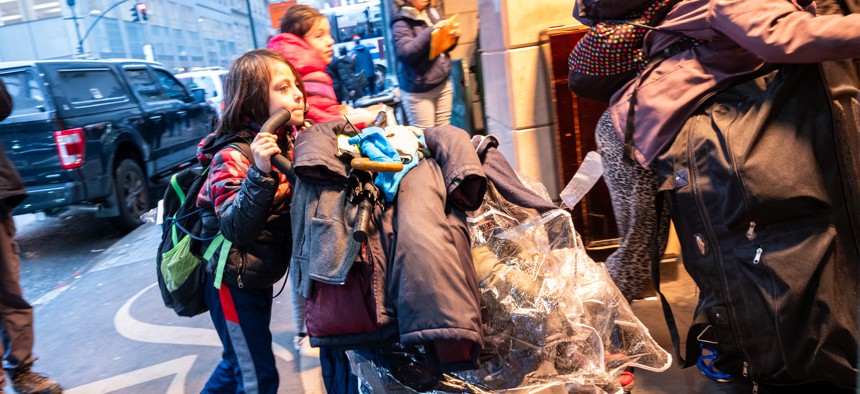Heard Around Town
New York City Council finds migrant children evicted from shelters saw school interrupted
New data tracking the impact of 60-day limits on shelter stays has created concerns.

Migrant families check into a processing center at the Roosevelt Hotel in midtown Manhattan Jan. 09, 2024. (Photo by Spencer Platt/Getty Images)
Nearly one in five migrant children who’ve been subject to a 60-day notice to leave their shelter have had their schooling interrupted mid-year, according to new data from the New York City Council.
“It's disheartening to see the impact of eviction notices rippling through our communities,” Council Member Rita Joseph, chair of the council’s Education committee, said in a statement.
The data, which covers up to March 3, tracks how the city’s controversial new policy restricting how long migrant families can stay in certain shelters has impacted the population since eviction notices began taking effect in early January. Of the 8,233 families with children who have had their time expire through March 3, 51% are still staying in the city’s sprawling shelter system. Of those families, 14% remain in the same shelter where their 60-day notice was issued and 81% now live in a different shelter – albeit one located in the same borough as their original placement.
All together, about 5,700 New York City students staying in one of the city’s Humanitarian Emergency Response and Relief Centers would have been impacted by the city’s 60-day notice policy as of early March. And while 82% of those children are still enrolled in the same school, council members are particularly concerned about the rest. Of those 1,026 students, two out of three – roughly 678 children – are no longer in enrolled in a New York City public school. The other third – around 302 children – transferred to a different school.
While the specific reason why each of those children are no longer enrolled in school is unclear, council members are expressing concerns that their absence may be evidence of a “disturbing trend” in need of urgent monitoring as more 60-day eviction notices take effect for migrant families with children. A City Hall spokesperson pointed out that it isn’t fair to assume that the 678 children didn’t remain in school because their 60-day notice expired.
They also noted that tens of thousands of migrants have accepted tickets to leave the city or have chosen to leave on their own.
City Council Deputy Speaker Diana Ayala said she hopes the data persuades the Adams administration to rethink the 60-day policy.
“Over a thousand children have had their education disrupted because of the cruel 60-day eviction rule for families in shelter,” Ayala, chair of the Council’s Committee on General Welfare, said in a statement. “This is a blow to the long-term development and success of each child that has their schooling interrupted. While it is commendable that the re-application for shelter process is taking less than one day, 2 out of 3 children that have been evicted and no longer remain in the same school have not re-enrolled in a new school.”
The 60-day policy has garnered a wave of pushback ever since it was first announced by Mayor Eric Adams last fall. While the Adams administration has billed it as a necessary way to drive down costs and maintain shelter space for the newest, most vulnerable arrivals, educators, immigrant advocates and council members contend uprooting families will only compound the trauma that many of the tens of thousands of migrant children enrolled in New York City schools endured to get to the United States. Absenteeism rates – already particularly high for homeless students – is another thing critics have feared will grow as migrant families reassigned to a distant shelter weigh a longer commute or transfering schools.
Single migrant adults staying in the city’s Humanitarian Emergency Response and Relief Centers are also subject to a similar policy, limiting their shelter stays to 30 days before they’d need to apply for a new placement or be forced to leave the system. The Adams administration has repeatedly emphasized that the 30 and 60-day policies are to help ensure no families with children end up sleeping on the streets. City officials have also said they are actively trying to keep families in the same borough as childrens’ school when making shelter reassignments.
“Our 30-and-60-day notices are one tool in our very limited toolbox to help migrants move on because, as we have repeatedly said, New York City is long past its breaking point,” a City Hall spokesperson said in a statement. “As notices expire for families with children, we continue to do everything in our power to minimize impacts as they take the next steps – especially for children already enrolled in our schools – and provide opportunities to re-apply for shelter if needed.”
Council Member Gale Brewer said her office has overseen dozens of cases in which families have been moved from her Upper West Side district to shelters in Queens and Brooklyn despite their enrollment in District 3 schools. While federal law requires the city to provide transportation to students living in temporary housing so they can remain in their same school even if they move, things tend to be more complicated in reality.
“Families are not given MetroCards. The school buses, with all due respect, just don’t show up. They don’t show up for New York kids and they’re not going to show up wherever you’re moving these families,” Brewer said in a statement. “Schools are stabilizing and supportive for children and their parents. Stability and support are exactly what these families need, not eviction notices.”
